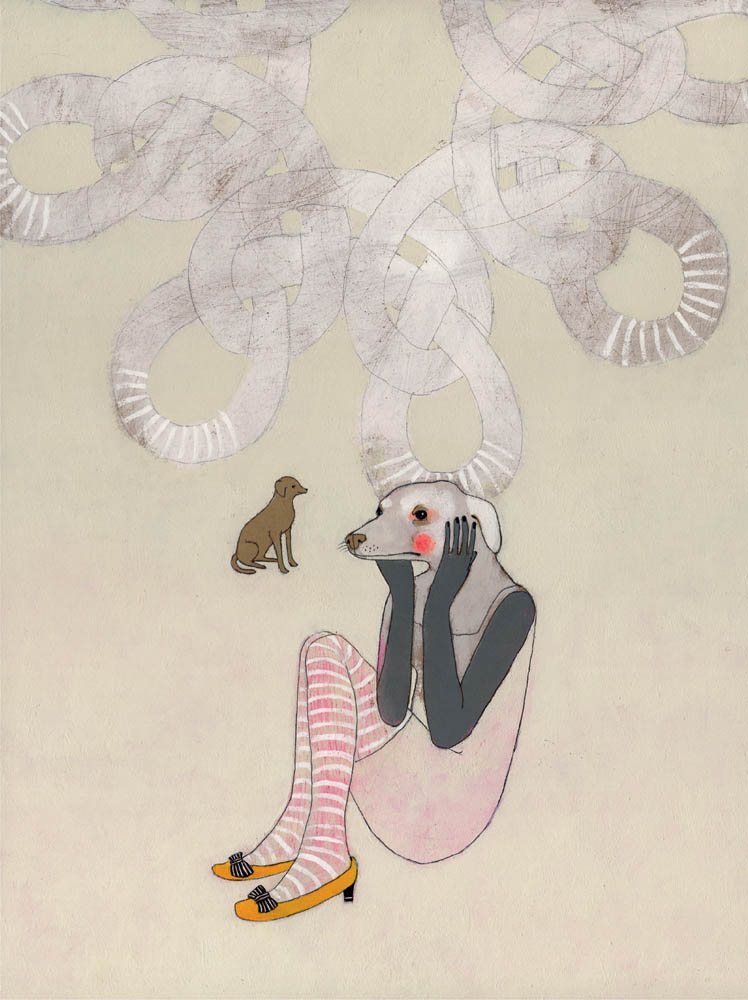Minneapolis-based artist Jennifer Davis graduated from the University of Minnesota with a bachelor of fine arts; however, she attributes most of her real learning to some very precious alone time in the studio, with only a table full of acrylic paints, pencils, and smooth panels to keep her company. Her paintings are whimsical, bizarre, and overflowing with beautiful little details. Crazy carousels, yellow monkeys, dogs in stripy tights—clearly, that quiet studio is the perfect place for amazing things to happen.
JC—When did you realize that you wanted to be an artist?
JD—Art was never really part of my life until my early twenties, when I discovered art classes in college. I made a lot of art all the time, and it was making me happier by the day. When I graduated from art school in 1998 I knew it was going to be a major part of my life. I felt so lucky to gain that knowledge.
JC—Why are you an artist today?
JD—I am an artist because I love making art. When I don’t paint, I get ornery and fussy. I am at my best when I am focused and spending a lot of time in my studio.
JC—If you weren’t an artist, what would you be?
JD—Some of my friends call me “Detective Davis” because of my interests in investigating, researching, spying, binoculars, and being nosy. I think it would be fun to be a detective, an investigator, or a spy.
JC—Are you quick to toss a painting that’s not working the way you want it to?
JD—If a painting is not working, I always give it one more chance. I set it aside for a day or two and take another look before deciding to toss it, rework it, or completely paint over it. This happens all the time.
JC—Does criticism affect you?
JD—If some criticism truly resonates, I try to figure out why and apply that knowledge to my thinking. If it doesn’t interest me I’ll just move along. I do my work for me, so I try not to let anyone else’s opinion bother me too much.
JC—Does your inner critic’s opinion bother you?
JD—My inner critic isn’t a bad guy, so I don’t ignore it. I don’t dwell in negativity, but if something is really nagging at me, I will just keep working to fix it or make improvements where I am able.
JC—Are there any tried and true techniques you use if a painting is causing problems?
JD—Yes, I paint several layers of color onto a panel and then use a straight razor to gently shave/scrape into the layers. (Sandpaper works too.) This creates interesting textures and shapes. I call them “ghost images”; they inevitably trigger an idea.
Another exercise I do is to consult my vast collection of found images; I have boxes and piles of them all over my studio. I reach into a pile and grab a half-inch stack of found images and then force myself to make a painting or collage based on one or more of the things from that stack. I find that sometimes a bit of self-imposed limitation can be helpful.
JC—Where do you find the images that wind up in those boxes and piles?
JD—I have been collecting found images for about fifteen years. I have boxes and folders stuffed full of them, and they are organized so I know where to find each one. I revisit some of them over and over in my work, and sometimes I even recognize them in the work of other artists. My favorites come from vintage magazines. I like National Geographic from the ’40s through the ’70s best. I also like vintage LOOK and Good Housekeeping, my Sears catalog from the ’30s, as well as large-format fashion magazines like W. Vintage children’s books also trigger inspiring memories for me; I have saved some from my own childhood. I also collect scraps of paper that I come across randomly in my daily life. Sometimes there is beauty in receipts, envelopes, take-out menus, and even junk found on the ground.
JC—How do you handle creative blocks?
JD—My inspiration tends to come in waves. If I can allow myself the time to take a break from the studio during the ebb, I will do so gladly. However, sometimes, tight deadlines for exhibitions and projects make taking a break difficult. I have become pretty adept at working through creative blocks. I usually just force myself to start making something (which is the hardest part when I am blocked), and I continually remind myself that nobody else ever has to see it if it doesn’t turn out well. As long as I keep working, I know the flow will eventually resume. It always does.

When I don’t paint, I get ornery and fussy.
